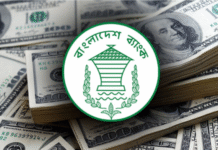 The work on the Padma Bridge project is in progress and so far 18% of the project has been implemented. Its estimated cost has increased by about Tk 8,300 crore (Tk 83 billion).
The work on the Padma Bridge project is in progress and so far 18% of the project has been implemented. Its estimated cost has increased by about Tk 8,300 crore (Tk 83 billion).
The work has gained momentum, but with uncertainties over funding, the train line may not operate from the day one of operation of the bridge over the mighty river.
The plans drawn up by the bridge division indicates that the main piling work will commence in October. In May next year, the bridges spans will be placed on the pillars. The bridge will be open for use in 2018. Presently, test piling is being carried out.
In the meantime, the railways ministry has taken up a project to construct a 160km railway line on either side of the Padma bridge. This entails a cost of about Tk 25 crore (Tk 250 million), though the funds have not been arranged as yet. The government is trying to get China to fund the project.
Work on the Padma bridge is broadly divided up into five parts. These are, the main bridge, river training, two link roads and infrastructure (service area) construction. There is also land acquisition and resettlement. So the work has mostly centred on land acquisition, resettlement, link roads and infrastructure.
China’s China Major Bridge Engineering Corporation (MBEC) was appointed last June at a cost of Tk 12,133 crore (Tk 121 billion) for the main bridge. The contractors were given 15% of the payment as soon as they were appointed. In November last year, China’s Sinohydro Corporation was given the river training contract for Tk 8,707 crore (Tk 87.07 billion). Bangladesh’s Abdul Monem Limited was given the contract for the two link roads and infrastructure construction. The contract was signed towards the end of 2013.
A total of 75% of Padma bridge project costs will have to be paid in foreign exchange.
An official of the bridges division, on condition of anonymity, said there are quite a few challenges to tackle if the work is to be finished on time. The equipment and goods must reach on time. The piling must be done at the depth as stipulated in the design. If there is any difference, the project work will be delayed, the official pointed out and cautioned that if there are any complications or irregularities in decision making, the speed of work will slow down. “The biggest challenge is the Chinese company. There are instances in Bangladesh of Chinese companies’ delays and sub-standard work,” the official added.
A team of Prothom Alo journalists on Friday visited on-going work of the Padma bridge project in Mawa of Munshiganj, Janjira of Shariatpur and Shibchar of Madaripur. The 6.15-km Padma bridge will stretch between Mawa and Janjira. This will be a two-tier bridge, with vehicles plying on top and trains below.
The bridge will go through the Mawa intersection. The ferry terminal has been relocated from there to Shimulia, 2.5km away.
Where the ferry terminal would stand, there are two cranes now, one of 500-tonne and the other of 250-tonne capacity and a few 50-tonne capacity cranes on a floating barge, carrying out the test piling. No one is allowed near the place without safety clothing and helmets.
Supplies for the bridge have been kept in a large field by the river at Komarbhog in Mawa. Huge sheds have been erected for the equipment and for the contracting companies’ people to stay. Two jetties have also been set up for the supplies to be unloaded and brought to the field.
According to the bridges division, 7.83% of the work had been done till April.
River training is at its initial stage. Sandbags are being carried in barges and dumped into the river. Three dredgers, a multi-purpose vessel, a tugboat, a three-anchor boat, 25 containers and about 500 dredging pipes have been brought to the project site. River training will be carried out 14-km along the two banks of the river.
And 42% of the work on the 14-km link road at the Mawa and Janjira end has been completed. Infrastructure had progressed 33%. The infrastructure includes the office building, laboratory, mosque, health centre, a duplex building motel, an overhead water tank and power sub-station, guard quarters and fire fighting system.
Padma bridge project director Shafiqul Islam told Prothom Alo that a large chunk of time is spent on the preparatory stage. Work has begun. By the next year the actual bridge will take shape, he said.
Increase in time and costs: Towards the beginning of the month, the bridges division sent a Tk 28,793 crore (Tk 287.93 billion) amended project proposal for Padma bridge to the planning commission. The project tenure was determined to be up till 2019.
After complications arose with the World Bank over financing the bridge, in 2012 the government took the decision to construct the bridge with its own funds. In 2011 the project proposal was changed once and the cost was fixed at Tk 20,507 crore (Tk 20.07 billion). Work was to be completed by December 2015.
The main project proposal of Padma Bridge was approved in 2007. The estimated cost at the time was Tk 10,161 crore (Tk 101.61 billion).
Shafiqul Islam said, “The first cost was an estimate. The contractors hadn’t been appointed then. The estimate given now is the actual cost. The work has increased to an extent too.”
Work on the main bridge: Steel piles of 1.5 metre radius are being placed on an experimental basis. Test piles will be placed in 10 places of the river. The main pile will be of three metre radius and will be placed at a slight angle. The bridge will have a total of 42 pillars. Each will have six piles beneath. Steel spans will be placed on the pillars. The bridge will have a total of 41 spans.
So far 2,700 tonnes of steel plates have arrived for the test and the main piling work. More will arrive in batches.
There is a 2,400-tonne hammer in Mongla. This will be used to place in the main piles. There is a 1,000-tonne capacity crane in Mongla to keep the piles in place. The bridge spans will be made in the construction grounds. A 2,500-tonne capacity cane will be required to put those in place. The crane has not arrived as yet.
A five-member German team of experts will be coming this month to operate the hammer.
Uncertainty over railway at the outset: With funds not ensured as yet, there is uncertainty over railway communication over the bridge at the outset. When the project was taken up, it had been aid that rains would ply on the bridge from the very first day.
The government has submitted a proposal to the Chinese government for railway line construction. If China agrees, a government to government (G2G) agreement will be signed between the two countries. If the agreement is signed, then a Chinese firm will construct the railway line.
The railway authorities have held initial talks with the China Railway Group. The company is constructing a new railway line along the Tongi-Bhairab Bazar route. China Major Bridge, the company which has the contract for the main Padma bridge, is a company of the Railway Group.
Of the 160-km railway line on both sides of Padma, 82.32 km is from Dhaka’s Gandaria to Keraniganj, and 77.6 km from Bhanga to Jessore.
The Australian-based consultancy firm SMACK carried out the feasibility study for the railway line.
The railway project director Sagar Krishna Chakrabarty told Prothom Alo, the government has attached priority to the railway line from the very beginning. He hopes that China will provide funds and work on the railway track can begin next year.
Source: Prothom Alo









